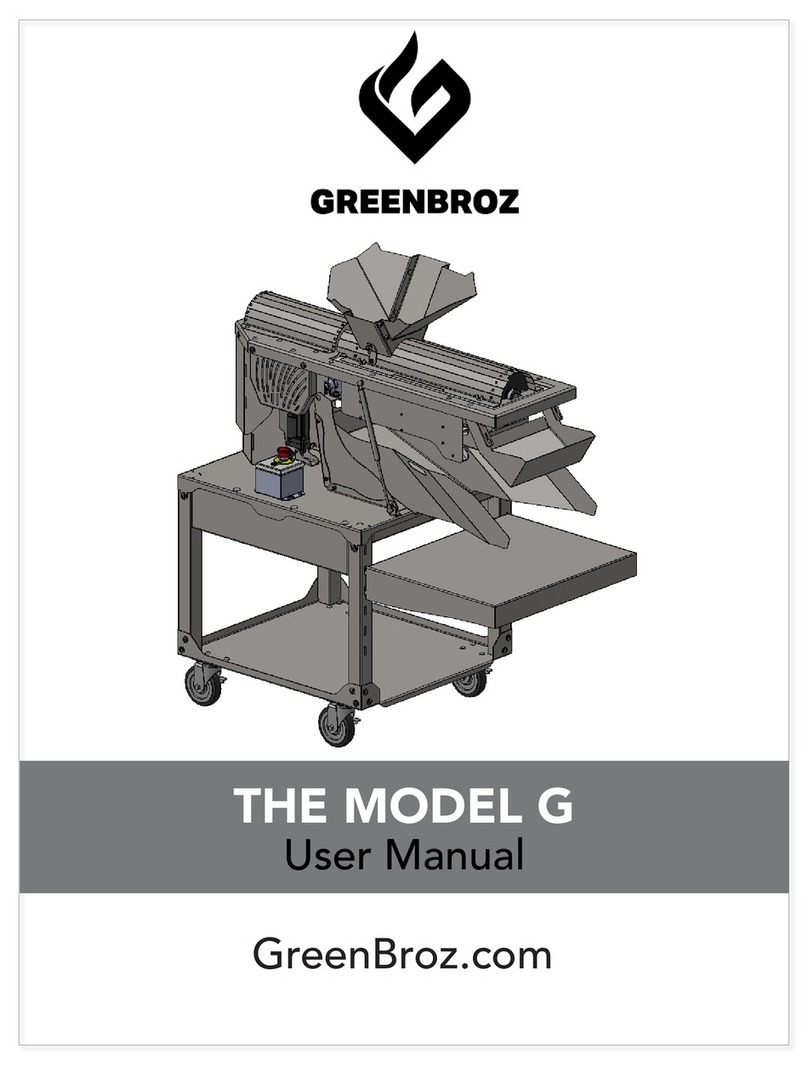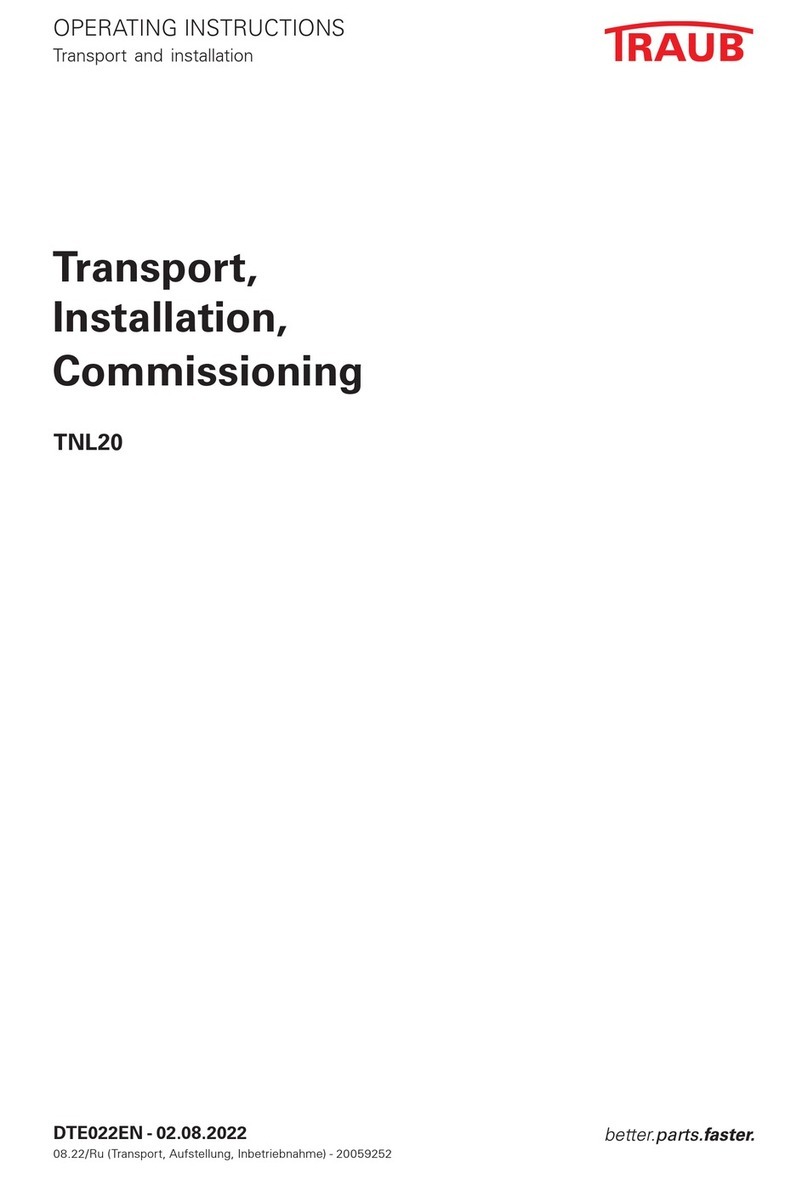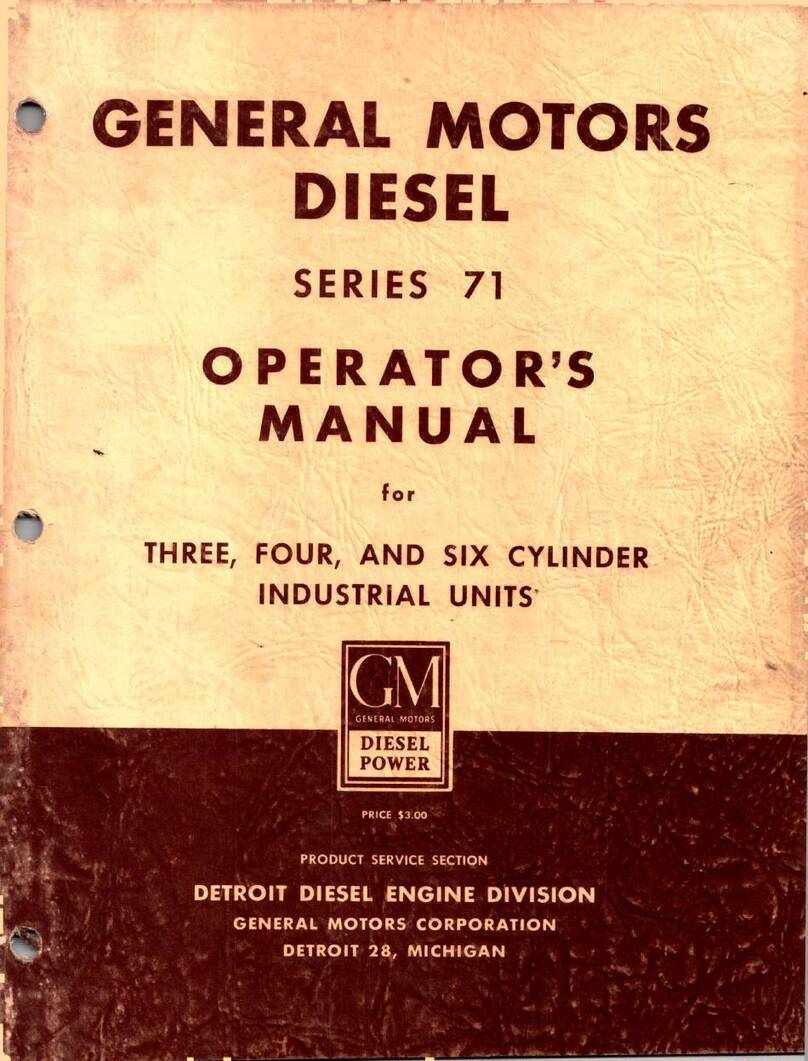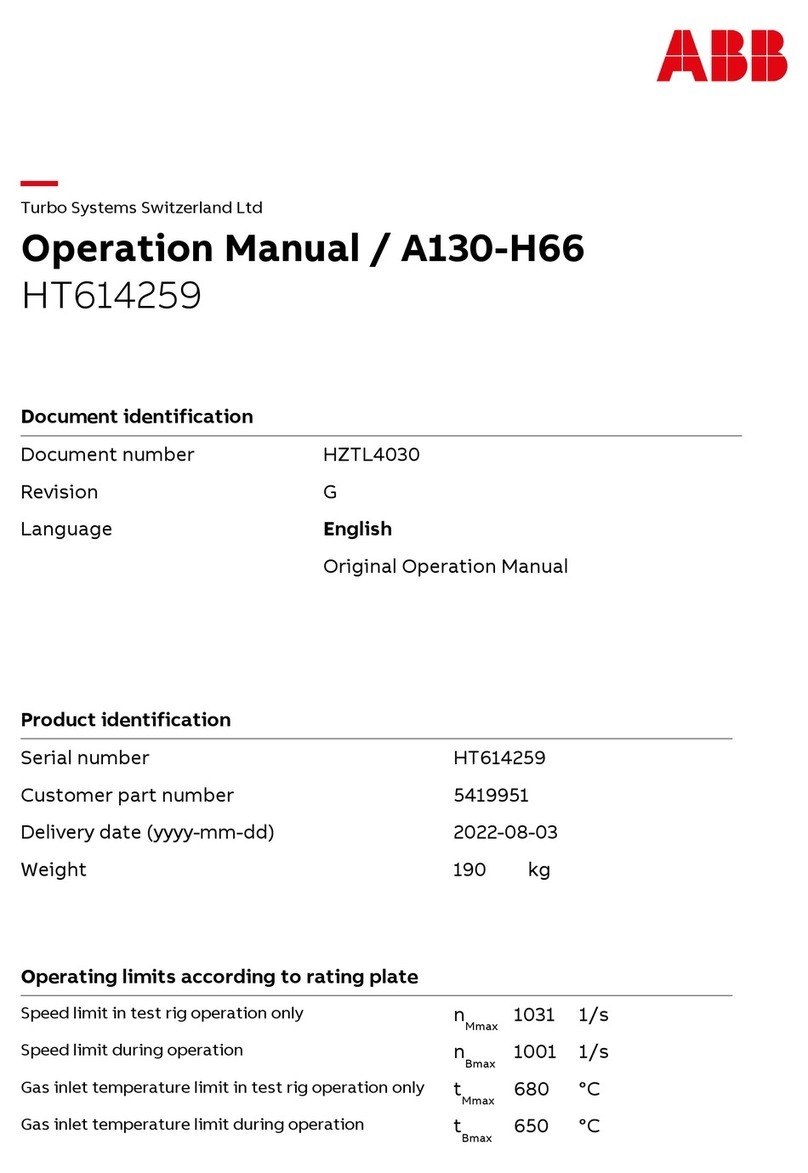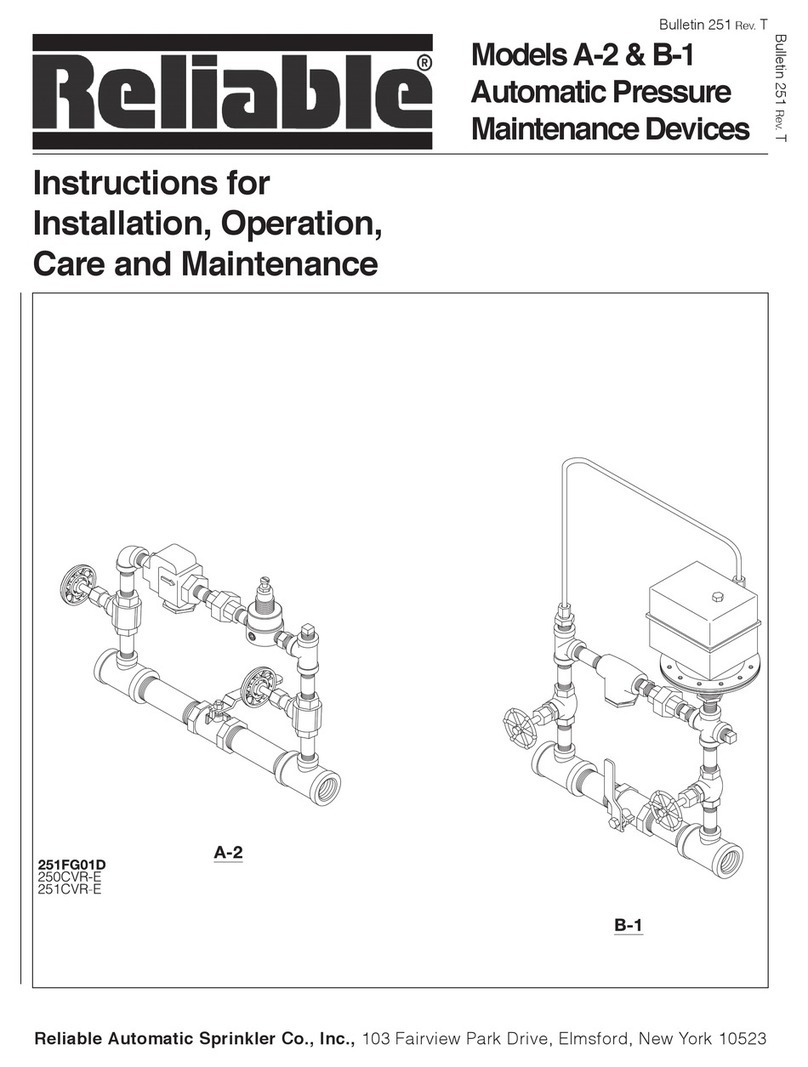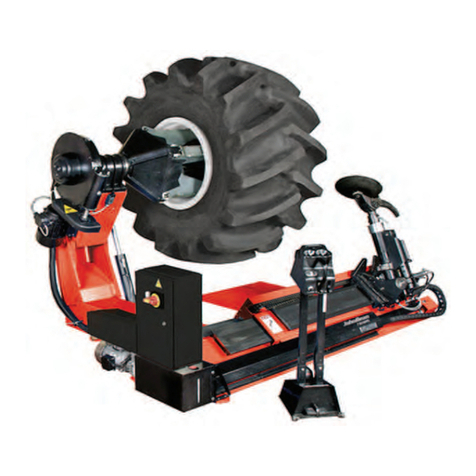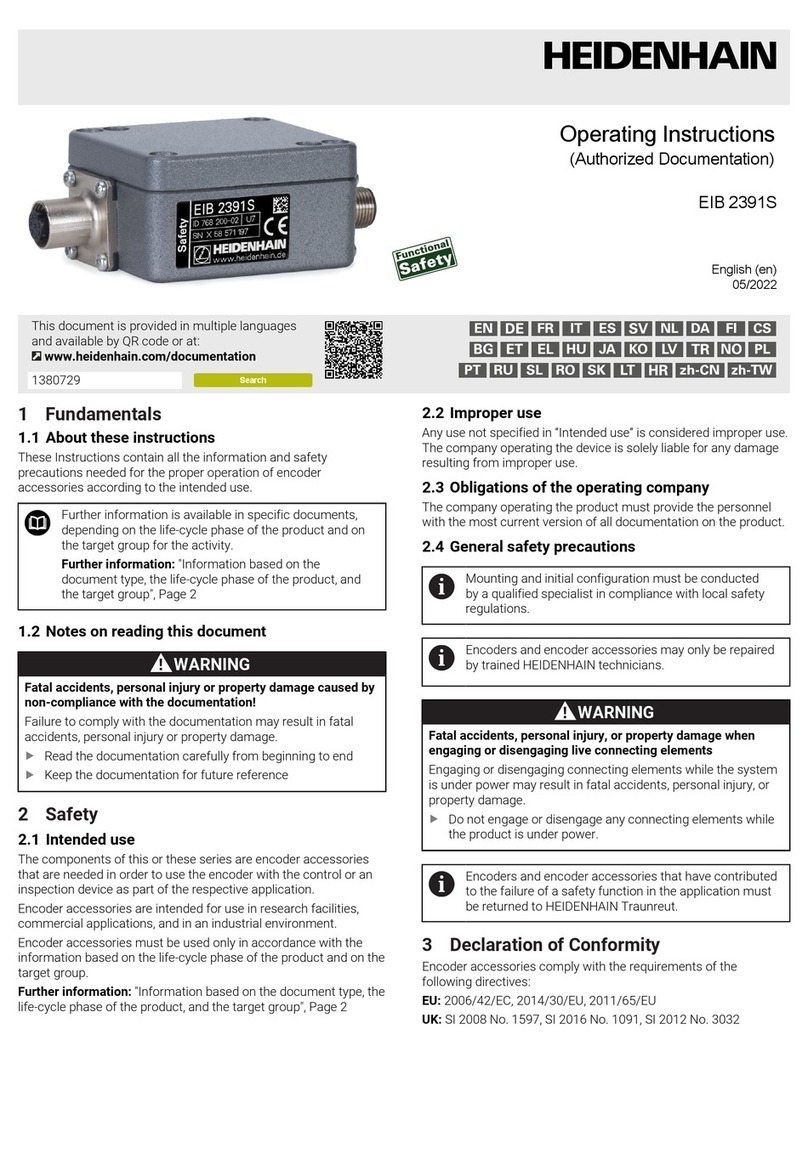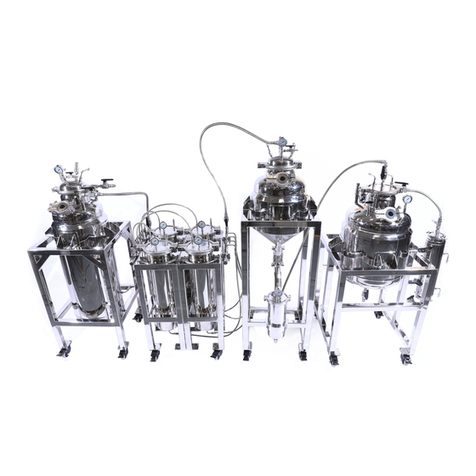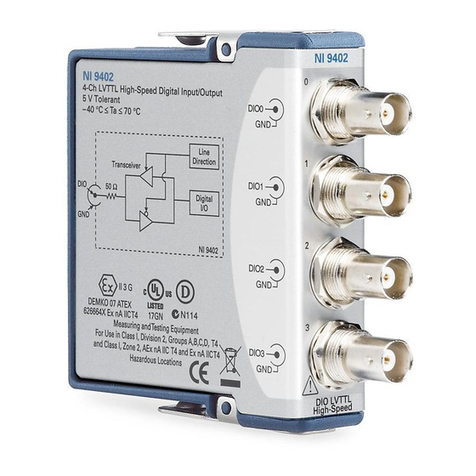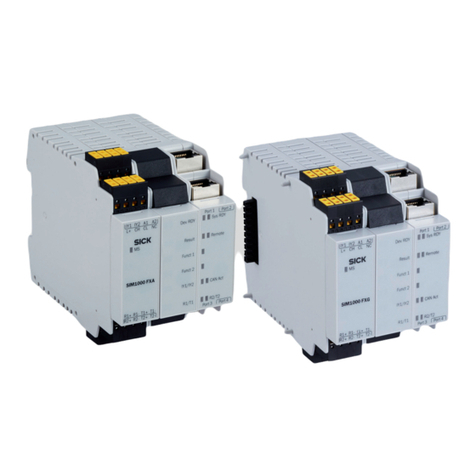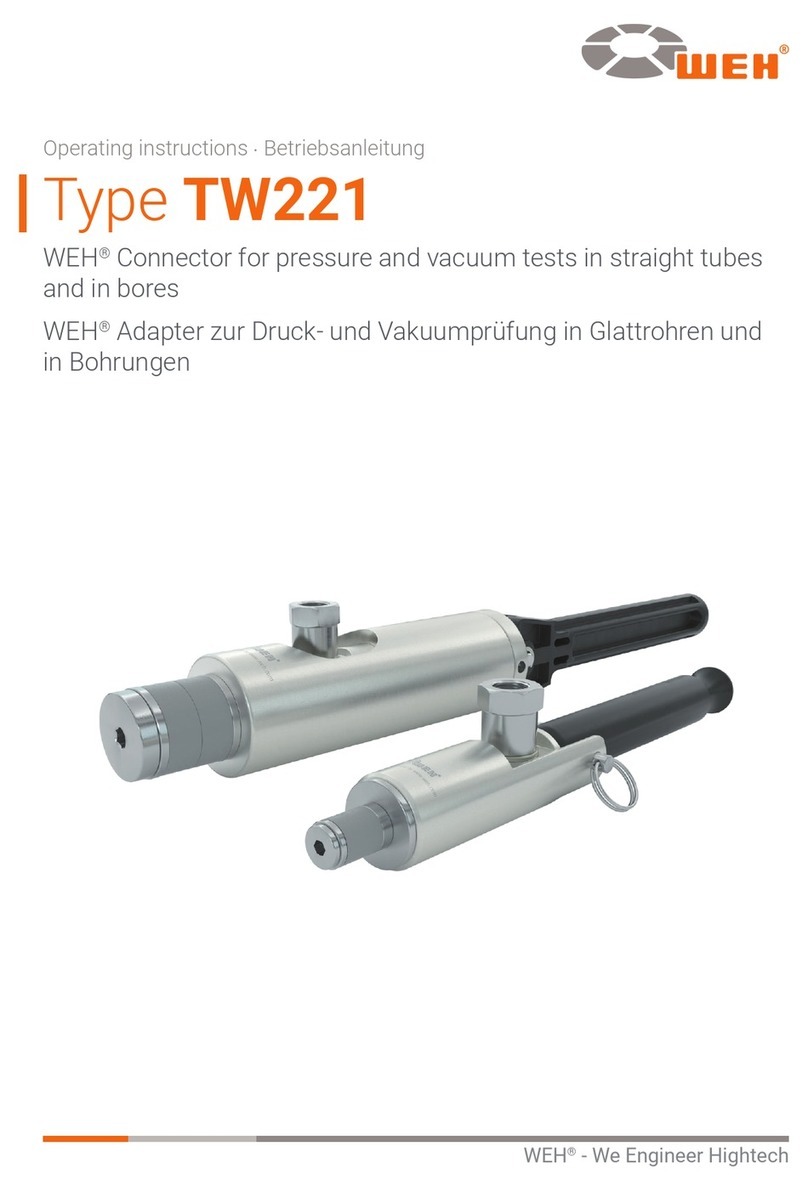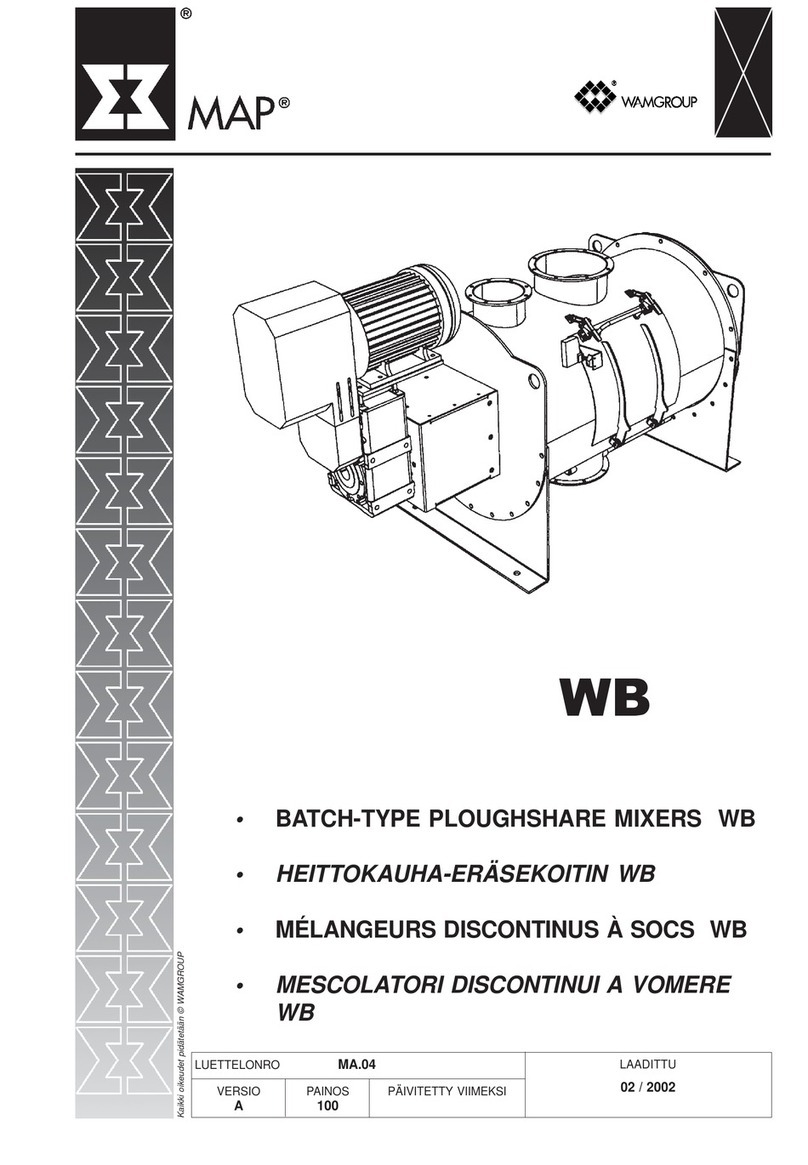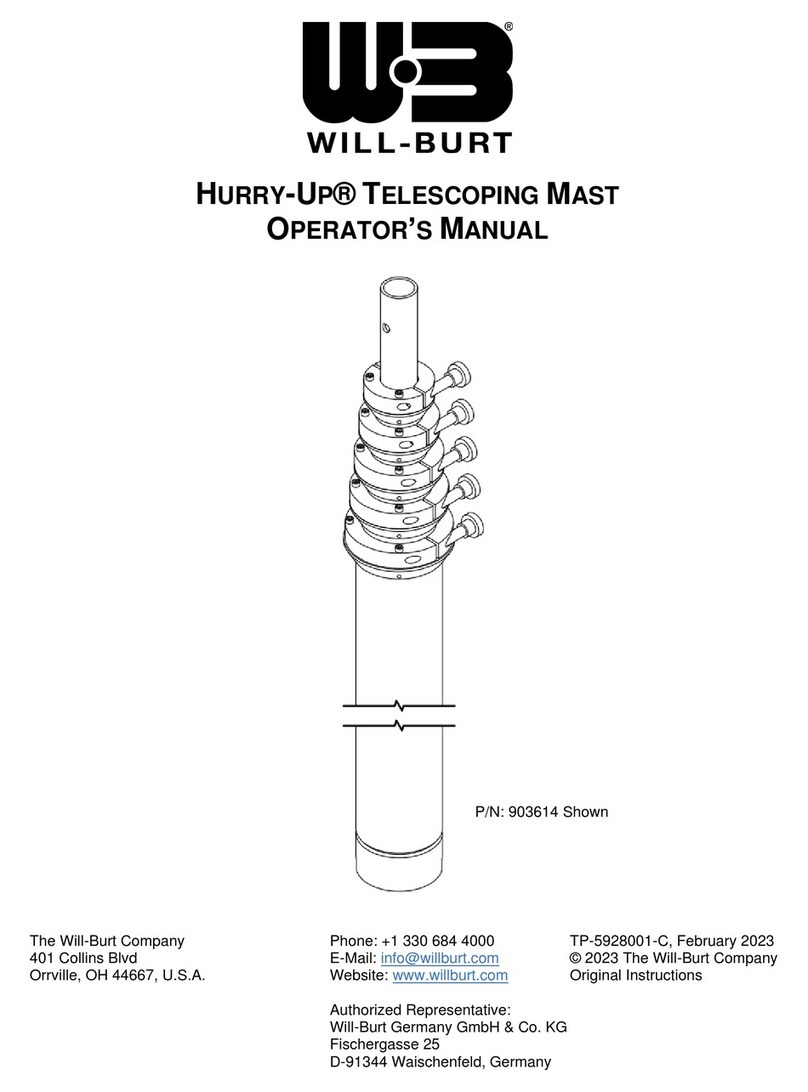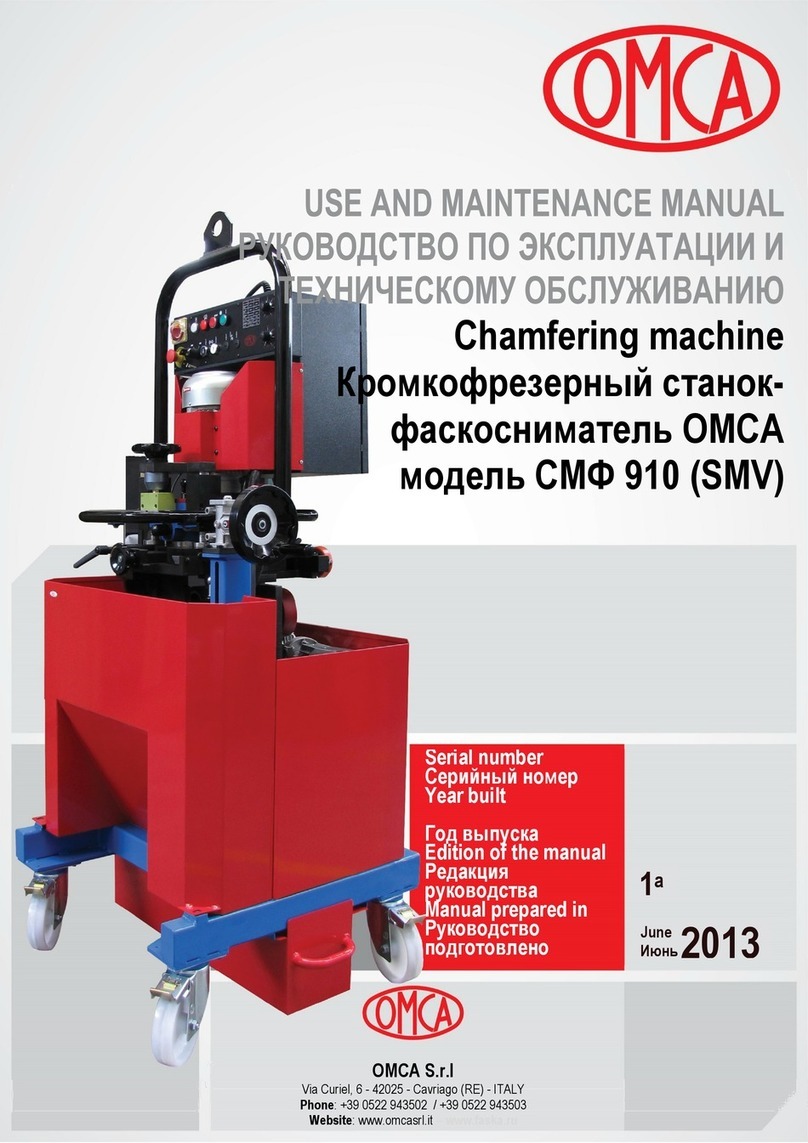Kemper EVOLUTION LINE User manual

Machine type: Evolution Line
Machine number:
Edition: April 2011
© GmbH
This operating manual and all images contained herein are copyright protected. Any use outside the
limitations of the copyright without prior written approval is forbidden and liable to prosecution. This
applies especially for reproduction, translation, microfilming, saving and editing in electronic systems.

Contents
Emil Kemper GmbH EVOLUTION LINE roll machine I
Contents
1 Introduction..........................................................................................................................................1
1.1 Notational conventions.......................................................................................................................1
1.2 Symbols used on the line...................................................................................................................2
1.3 Safety information ..............................................................................................................................2
1.3.1 General safety information......................................................................................................3
1.3.2 Personal protective equipment ...............................................................................................3
1.3.3 Safety devices and guards......................................................................................................3
1.3.4 Electric power hazards............................................................................................................4
1.3.5 Pneumatic power hazards.......................................................................................................4
1.3.6 Flour dust and sugar hazards .................................................................................................5
1.3.7 Information for emergencies ...................................................................................................5
1.3.8 Training level of personnel......................................................................................................5
1.4 Residual risks.....................................................................................................................................6
1.5 Intended use.......................................................................................................................................6
1.6 Structural alterations to the line..........................................................................................................7
1.7 Cleaning and waste disposal..............................................................................................................7
1.8 Obligations of the plant operator........................................................................................................7
1.9 Obligations of personnel.....................................................................................................................8
1.10 Warranty and liability........................................................................................................................8
2 Transport and storage ........................................................................................................................9
2.1 Inspection by the recipient on handover ............................................................................................9
2.2 Packaging...........................................................................................................................................9
2.3 Transport information .......................................................................................................................10
2.4 Temporary storage...........................................................................................................................11
3 Installation..........................................................................................................................................13
3.1 Erecting the line................................................................................................................................13
3.2 Choice of installation site..................................................................................................................14
3.2.1 Necessary operating and maintenance space......................................................................14
3.2.2 Floor requirements................................................................................................................15
3.3 Erecting the line................................................................................................................................15
3.4 Electrical characteristics of the supply network................................................................................15
3.4.1 Preparations..........................................................................................................................16
3.4.2 Rating plate...........................................................................................................................17
3.4.2.1 Line 17
3.4.2.2 Roll-out station........................................................................................................18
3.4.2.3 Reciprocating belt...................................................................................................19
3.4.2.4 Reciprocating belt AB60.1......................................................................................20
4 Commissioning .................................................................................................................................21
5 Overview of the line ..........................................................................................................................23
5.1.1 Overview of the basic module assembly...............................................................................23
5.1.2 Overview of the roll-out station assembly.............................................................................24
5.2 Overview of the lines modules' function elements...........................................................................25
5.2.1 Function elements of the basic module ................................................................................25

Contents
II EVOLUTION LINE roll machine Emil Kemper GmbH
5.2.2 Function elements of the discharge belt 1 ........................................................................... 26
5.2.3 Function elements of the pressure roller.............................................................................. 27
5.2.4 Function elements of the roll-out roller................................................................................. 28
5.2.5 Function elements of the centering unit ............................................................................... 29
5.2.6 Function elements of the cutting station............................................................................... 30
5.2.7 Function elements of the pre-pressing station..................................................................... 31
5.2.8 Function elements of the conveyor belt ............................................................................... 32
5.2.9 Function elements of the flour duster with flour break-up shaft........................................... 33
5.2.10 Function elements of the long-moulding belt ..................................................................... 34
5.2.11 Function elements of the folding mats ............................................................................... 35
5.2.12 Function elements of the alignment and pressure roller (timing roller).............................. 37
5.2.13 Function elements of the reciprocating belt ....................................................................... 38
5.2.14 Function elements of reciprocating belt AB60.1................................................................. 39
5.3 Overview of the operator controls.................................................................................................... 40
5.3.1 Operator controls of the basic module ................................................................................. 40
5.3.2 Operator controls of the discharge belt 1............................................................................. 42
5.3.3 Operator controls of the pressure roller................................................................................ 43
5.3.4 Operator controls of the roll-out roller................................................................................... 44
5.3.5 Operator controls of the centering unit................................................................................. 45
5.3.6 Operator controls of the cutting station ................................................................................ 46
5.3.7 Operator controls of the pre-pressing station....................................................................... 47
5.3.8 Operator controls of the flour duster with flour break-up shaft............................................. 48
5.3.9 Operator controls of the long-moulding station top belt ....................................................... 49
5.3.10 Operator controls of the folding mats................................................................................. 50
5.3.11 Operator controls of the alignment and pressure roller (timing roller)................................ 51
5.3.12 Operator controls of the reciprocating belt......................................................................... 52
5.3.13 Reciprocating belt AB60.1.................................................................................................. 53
5.4 Overview of safety devices.............................................................................................................. 54
6 Description of the line...................................................................................................................... 55
6.1 Basic module................................................................................................................................... 55
6.2 Discharge belt 1............................................................................................................................... 56
6.3 Pressure roller ................................................................................................................................. 56
6.4 Roll-out roller ................................................................................................................................... 56
6.5 Centring unit .................................................................................................................................... 56
6.6 Cutting station.................................................................................................................................. 57
6.7 Pre-pressing station......................................................................................................................... 57
6.8 Conveyor belt................................................................................................................................... 57
6.9 Flour duster with flour break-up shaft.............................................................................................. 57
6.10 Long-moulding belt........................................................................................................................ 58
6.11 Folding mats.................................................................................................................................. 58
6.12 Alignment and pressure roller (timing roller) ................................................................................. 58
6.13 Reciprocating belt.......................................................................................................................... 59
6.14 Reciprocating belt AB60.1............................................................................................................. 59
6.15 Electrical equipment ...................................................................................................................... 59
6.16 Switchbox ...................................................................................................................................... 60
6.17 Touch panel................................................................................................................................... 61
6.17.1 Password levels.................................................................................................................. 62
6.17.2 Structure of the main and sub-menus................................................................................ 63
6.17.3 Start screen........................................................................................................................ 64

Contents
Emil Kemper GmbH EVOLUTION LINE roll machine III
6.17.3.1 Displays ................................................................................................................65
6.17.3.2 Buttons and illustrations........................................................................................66
6.17.4 Illustration of the assemblies and line modules ..................................................................67
6.17.4.1 'Proofer menu'.......................................................................................................68
6.17.4.2 Roll-out station menu............................................................................................72
6.17.4.3 'Cutting station menu' ...........................................................................................77
6.17.4.4 'Reciprocating belt menu'......................................................................................81
6.17.5 RECIPE button......................................................................................................................87
6.17.6 INFO button ..........................................................................................................................89
6.17.7 ACK BUTTON .........................................................................................................................90
6.17.8 MENU button ........................................................................................................................91
6.18 Safety devices and guards.............................................................................................................92
6.18.1 EMERGENCY STOP button......................................................................................................92
6.18.2 EMERGENCY STOP button on the operator panel..................................................................93
6.18.3 Limit switches......................................................................................................................93
7 Operation............................................................................................................................................95
7.1 Switching the line on and off ............................................................................................................95
7.2 Switching the control voltage on ......................................................................................................96
7.3 Setting assemblies...........................................................................................................................96
7.3.1 Basic module.........................................................................................................................96
7.3.1.1 Switching on the steam generator system..............................................................96
7.3.1.2 Setting the heating, convection, sterilization and drying.........................................97
7.3.1.3 Setting a recipe at the basic module ......................................................................97
7.3.2 Roll-out station ....................................................................................................................103
7.3.2.1 Setting a recipe at the roll-out station...................................................................103
7.4 Setting the line modules.................................................................................................................106
7.4.1 Setting the discharge belt....................................................................................................106
7.4.1.1 Adjusting the height of the pressure roller............................................................106
7.4.2 Setting the discharge belt 1 ................................................................................................107
7.4.2.1 Setting the pressure roller height on the pressure roller line module...................107
7.4.3 Setting the pressure roller...................................................................................................108
7.4.3.1 Adjusting the height of the pressure roller............................................................108
7.4.4 Setting the roll-out roller......................................................................................................109
7.4.4.1 Adjusting the height of the roll-out roller...............................................................109
7.4.5 Setting the centering unit ....................................................................................................109
7.4.5.1 Replacing the centering flap.................................................................................109
7.4.5.2 Setting a recipe at the centering unit....................................................................110
7.4.6 Setting the cutting station....................................................................................................112
7.4.6.1 Setting the cutting depth.......................................................................................112
7.4.6.2 Setting the hold-down...........................................................................................112
7.4.6.3 Setting the centering unit......................................................................................113
7.4.6.4 Setting the timing adjustment ...............................................................................114
7.4.6.5 Setting a recipe at the cutting station ...................................................................114
7.4.7 Setting the pre-pressing station ..........................................................................................117
7.4.7.1 Setting the pre-pressing depth..............................................................................117
7.4.7.2 Replacing the pre-pressing tool............................................................................118
7.4.7.3 Setting a recipe at the pre-pressing station..........................................................119
7.4.8 Setting the conveyor belt.....................................................................................................120

Contents
IV EVOLUTION LINE roll machine Emil Kemper GmbH
7.4.8.1 Setting a recipe at the conveyor belt.................................................................... 120
7.4.9 Setting the flour duster with flour break-up shaft................................................................ 121
7.4.9.1 Filling the flour duster with flour break-up shaft................................................... 121
7.4.9.2 Setting a recipe at the flour duster with break-up shaft ....................................... 122
7.4.10 Long-moulding belt........................................................................................................... 123
7.4.11 Setting the folding mats.................................................................................................... 126
7.4.11.1 Lifting folding mats out of the transport area ..................................................... 126
7.4.11.2 Setting the folding flaps...................................................................................... 126
7.4.12 Setting the alignment and pressure roller (timing roller) .................................................. 127
7.4.12.1 Setting the height of the alignment and pressure roller..................................... 127
7.4.12.2 Setting a recipe at the alignment and pressure roller........................................ 127
7.4.13 Setting the reciprocating belt............................................................................................ 129
7.4.13.1 Setting the wooden tray stop ............................................................................. 129
7.4.13.2 Setting a recipe at the reciprocating belt............................................................ 129
7.4.14 Reciprocating belt AB60.1................................................................................................ 134
7.5 Selecting a recipe via the touch panel........................................................................................... 140
7.6 Starting/Stopping the line .............................................................................................................. 142
7.6.1 Touch panel........................................................................................................................ 142
7.6.2 Operator panel.................................................................................................................... 142
7.7 Behaviour after triggering safety devices ...................................................................................... 143
7.7.1 EMERGENCY STOP button..................................................................................................... 143
7.7.2 Limit switches..................................................................................................................... 144
8 Cleaning and maintenance............................................................................................................ 145
8.1 Safety information for cleaning and maintenance......................................................................... 145
8.2 Cleaning and maintenance intervals ............................................................................................. 146
8.2.1 Every 10 operating hours or daily....................................................................................... 146
8.2.1.1 Basic module........................................................................................................ 146
8.2.1.2 Roll-out station..................................................................................................... 146
8.2.1.3 Centring unit......................................................................................................... 146
8.2.1.4 Conveyor belt....................................................................................................... 147
8.2.1.5 Flour duster with flour break-up shaft .................................................................. 147
8.2.1.6 Long-moulding belt............................................................................................... 147
8.2.1.7 Folding mats......................................................................................................... 147
8.2.1.8 Alignment and pressure roller (timing roller)........................................................ 148
8.2.1.9 Reciprocating belt ................................................................................................ 148
8.2.1.10 Reciprocating belt AB60.1 ................................................................................. 148
8.2.2 Every 50 operating hours or weekly................................................................................... 148
8.2.2.1 Basic module........................................................................................................ 148
8.2.2.2 Discharge belt 1................................................................................................... 149
8.2.2.3 Conveyor belt....................................................................................................... 149
8.2.2.4 Reciprocating belt ................................................................................................ 149
8.2.2.5 Reciprocating belt AB60.1.................................................................................... 150
8.2.3 Every 200 operating hours or monthly ............................................................................... 150
8.2.3.1 Basic module........................................................................................................ 150
8.2.3.2 Discharge belt 1................................................................................................... 150
8.2.3.3 Long-moulding belt............................................................................................... 151
8.2.3.4 Reciprocating belt ................................................................................................ 151
8.2.3.5 Reciprocating belt AB60.1.................................................................................... 151
8.2.4 Every 700 operating hours or every three months............................................................. 152

Contents
Emil Kemper GmbH EVOLUTION LINE roll machine V
8.2.5 Inspection every 1400 operating hours or every half-year..................................................152
8.3 Cleaning and maintenance tasks...................................................................................................152
8.3.1 Preparations........................................................................................................................152
8.3.2 Basic module.......................................................................................................................153
8.3.2.1 Cleaning the collecting trays.................................................................................153
8.3.2.2 Tensioning the cup chains....................................................................................154
8.3.2.3 Lubricating the cup chains....................................................................................155
8.3.3 Roll-out station ....................................................................................................................156
8.3.3.1 Cleaning collecting trays.......................................................................................156
8.3.4 Discharge belt 1 ..................................................................................................................157
8.3.4.1 Cleaning the belt...................................................................................................157
8.3.4.2 Tensioning the belt ...............................................................................................157
8.3.4.3 Cleaning the chain wheels....................................................................................158
8.3.5 Pressure roller.....................................................................................................................158
8.3.5.1 Cleaning the pressure roller..................................................................................158
8.3.6 Roll-out roller.......................................................................................................................159
8.3.6.1 Cleaning the roll-out roller.....................................................................................159
8.3.6.2 Cleaning the scraper.............................................................................................159
8.3.7 Centering unit......................................................................................................................160
8.3.7.1 Cleaning the centering flap...................................................................................160
8.3.7.2 Checking the pneumatic equipment .....................................................................162
8.3.8 Cutting station .....................................................................................................................163
8.3.8.1 Lubricating the triangular knife and knife guides..................................................163
8.3.8.2 Inspecting and replacing the triangular knife........................................................164
8.3.8.3 Checking the pneumatic equipment .....................................................................165
8.3.9 Belt stamp ...........................................................................................................................166
8.3.9.1 Cleaning the belt stamp........................................................................................166
8.3.10 Conveyor belt....................................................................................................................167
8.3.10.1 Cleaning the conveyor belt.................................................................................167
8.3.10.2 Tensioning the conveyor belt..............................................................................168
8.3.11 Flour duster with flour break-up shaft ...............................................................................168
8.3.11.1 Cleaning the flour container................................................................................168
8.3.11.2 Cleaning the flour cloth.......................................................................................169
8.3.12 Long-moulding belt............................................................................................................171
8.3.12.1 Cleaning the top belt...........................................................................................171
8.3.12.2 Tensioning the top belt .......................................................................................171
8.3.13 Folding mats......................................................................................................................172
8.3.13.1 Cleaning the wire mesh belts..............................................................................172
8.3.13.2 Cleaning the folding flaps ...................................................................................173
8.3.14 Alignment and pressure roller...........................................................................................174
8.3.14.1 Cleaning the alignment and pressure roller........................................................174
8.3.15 Reciprocating belt .............................................................................................................174
8.3.15.1 Cleaning the belt.................................................................................................174
8.3.15.2 Tensioning and lubricating the drive chain of the conveyor belt stroke..............175
8.3.15.3 Tensioning and lubricating the drive chain conveyor belt drive..........................176
8.3.15.4 Tensioning the conveyor belt..............................................................................177
8.3.15.5 Tensioning and lubricating the conveyor belt chains..........................................178
8.3.16 Reciprocating belt AB60.1 ................................................................................................179

Contents
VI EVOLUTION LINE roll machine Emil Kemper GmbH
8.3.16.1 Cleaning the belt................................................................................................ 179
8.3.16.2 Tensioning the drive chain of the conveyor belt pull-off..................................... 180
8.3.16.3 Tensioning the drive chain of the conveyor belt drive........................................ 181
8.3.16.4 Tensioning the conveyor belt............................................................................. 182
8.3.16.5 Tensioning the conveyor belt chains.................................................................. 183
8.3.16.6 Checking the pneumatic equipment................................................................... 184
8.4 Operating materials, lubricants and cleaning agents .................................................................... 185
8.4.1 Lubricant recommendations............................................................................................... 185
8.4.2 Greases.............................................................................................................................. 186
8.4.3 Storage of lubricants .......................................................................................................... 186
8.5 Stocking spare parts / Customer Service...................................................................................... 187
8.5.1 Stocking spare parts........................................................................................................... 187
8.5.2 Accessories........................................................................................................................ 187
8.5.3 Customer Service............................................................................................................... 187
8.6 Maintenance contracts................................................................................................................... 188
9 Faults ............................................................................................................................................... 189
9.1 Behaviour in case of faults ............................................................................................................ 189
9.2 Safety shutdown............................................................................................................................ 189
9.3 Start-up after a fault....................................................................................................................... 190
9.4 Troubleshooting............................................................................................................................. 191
10 Decommissioning, dismantling and disposal ........................................................................... 193
10.1 Decommissioning the line............................................................................................................ 193
10.2 Dismantling the line ..................................................................................................................... 193
10.3 Disposing of the line .................................................................................................................... 193
11 Appendix ....................................................................................................................................... 195
11.1 Technical data ............................................................................................................................. 195
11.2 Compliance with laws, standards and directives......................................................................... 195

Introduction
Emil Kemper GmbH EVOLUTION LINE roll machine 1
1 Introduction
This operating manual provides all the information you need to run the EVOLUTION LINE
roll machine (called line from now on).
After reading the operating manual you will be able to:
–operate the line safely,
–carry out maintenance according to the rules and
–take the necessary action in the event of a fault.
All persons working with the line must follow this operating manual (e.g. machine
operators, supervisors, mechanics, electricians). This applies in particular to the safety
information given in this chapter.
It is also necessary to obey the accident prevention rules in force at the point of use.
This operating manual must always be kept at the line's point of use.
1.1 Notational conventions
Passages of this user manual that require special attention or are a direct danger warning
are shown as follows:
Note!
This symbol indicates information about a function or setting or that care is
required.
Attention!
This symbol indicates potential damage to line components and how to
behave at the line.

Introduction
2EVOLUTION LINE roll machine Emil Kemper GmbH
Hazard!
This symbol indicates a particular hazard to health from the line and ways
of averting it.
Warning – electrical hazard!
This symbol indicates an electrical hazard.
Work on electrical equipment should only be carried out by qualified and
authorized electrical specialists.
The following conventions are also used:
–Text following this mark represents an item in a list.
Text following this mark describes actions to be performed in the specified order.
' ' Text in single quotation marks indicates screens on the touch panel.
" " Text in double quotation marks refers to other chapters or sections in this document.
ONText in small capitals indicates an operator control pushbutton/switch or a button /
input box on the touch panel.
1.2 Symbols used on the line
Warning – electrical hazard!
This symbol indicates an electrical hazard.
1.3 Safety information
Before working with the line you must carefully read the safety information below and
then follow it. It is intended to protect you, averting hazards and/or injuries.

Introduction
Emil Kemper GmbH EVOLUTION LINE roll machine 3
1.3.1 General safety information
–Do not exceed the technical performance and capacity limits.
–Keep all safety and danger signs on the line clean and renew them if necessary.
–The machine is only allowed to be operated by trained personnel.
–If the line malfunctions, take it out of operation immediately. Have faults rectified by
appropriately trained personnel.
–Follow the procedures described in this operating manual to switch the machine on
and off and watch the control indicators.
–Do not start the line if other persons are in the danger zone.
–Always keep the operating manual at the line's point of use.
1.3.2 Personal protective equipment
Wear the necessary personal protective equipment, e.g. safety shoes, whenever working
at the line.
These must be provided by the plant operator and must satisfy the requirements.
It is also necessary to obey national rules and the plant operator's internal instructions.
1.3.3 Safety devices and guards
–Before switching the line on always make sure that all safety devices and guards have
been fitted properly and are functional.
–The line's sound absorbers (panelling) must be attached during operation.
–Guards are only allowed to be removed
after the machine has come to a standstill and
after it has been prevented from being turned on again unexpectedly (e.g. by
locking the locally installed switch).
–When sub-components are delivered, the plant operator must ensure that the guards
are fitted according to the rules.
–You must not bridge or remove safety devices and guards or defeat them in any other
way.

Introduction
4EVOLUTION LINE roll machine Emil Kemper GmbH
1.3.4 Electric power hazards
–Always disconnect the power supply before carrying out work at the line (e.g. via the
main switch or a local switch installed by the plant operator) and ensure it cannot be
reconnected.
–Work in the electrical areas of the line should only be carried by a qualified electrical
specialist – e.g. plant electrician.
–Regularly check the line's electrical equipment for defects such as loose connections
or scorched cables. Have any defects rectified immediately.
–Have the electrical installations and fixed electrical equipment tested by an electrical
specialist every 4 years at least.
–Have non-fixed electrical equipment and extension and device cabling with plugs and
sockets tested by an electrical specialist, or by a trained person using suitable
inspection facilities, every 6 months at least.
Equipment is non-fixed if, by its nature and in its normal use, it is moved while under
power. This includes, for example, electric floor cleaners.
–Alterations made after testing must comply with DIN EN 60204-1.
–Only use original fuses.
1.3.5 Pneumatic power hazards
–Work on the pneumatic equipment should only be carried out by personnel with
specific knowledge of and experience with pneumatics.
–Before working on the equipment, switch it off and prevent it from being reconnected.
–Before starting repairs, depressurize the line sections that need to be opened and the
pressure pipes.
–Regularly inspect all pneumatic pipes, hoses and screw fittings for leaks and
externally recognizable damage.
–Carefully detach the hoses. The release of compressed air could whirl up dust.

Introduction
Emil Kemper GmbH EVOLUTION LINE roll machine 5
1.3.6 Flour dust and sugar hazards
–To avoid flour dust hazards, take operational measures to reduce the build-up of flour
dust as much as possible.
–Make sure that a flour dust concentration of 10 mg/m3of air in an 8-hour shift is not
exceeded.
–Wear fine-dust masks.
–Remove flour dust deposits regularly.
–Smoking and naked flames are prohibited in flour storage rooms and flour silos.
–Flour silo vehicles must be electrically earthed during unloading in order to avoid
electrostatic charging.
–Oak and beech sawdust must not be used.
–Keep contact with flour and dough to the bare minimum.
–Frequent washing of your hands and drying with a clean towel helps prevent baker's
eczema.
1.3.7 Information for emergencies
–In emergencies always press the EMERGENCY STOP button (red mushroom button on a
yellow background).
–Extinguish any burning oil with CO2or powder extinguisher.
–Use a CO2extinguisher to put out any fire in the electric control system.
–Always notify an emergency doctor in case of doubt.
1.3.8 Training level of personnel
–Everyone who works at the line must have read the operating manual and be aware of
and follow its content.
–The plant manager is obliged to instruct personnel on the basis of the operating
manual and to oblige them to obey the various rules and instructions.
–Auxiliary personnel and trainees are only allowed to work on the line under the
supervision of technical personnel.
–The responsibilities of personnel for installation, commissioning, operating,
maintenance and repair are to be clearly defined.

Introduction
6EVOLUTION LINE roll machine Emil Kemper GmbH
1.4 Residual risks
The line has a state-of-the-art design and complies with recognized safety rules and
regulations. But using it can still endanger life and limb of users or third parties or result in
damage to the actual line or other objects.
The line must only be used
–as intended (see section "1.5 Intended use") and
–in a perfectly safe state.
Any faults that could impair safety must be rectified immediately.
1.5 Intended use
Intended use – as set out by the applicable standard – is that use for which the technical
product is suited according to information provided by the manufacturer, including
information provided for advertising purposes.
In case of doubt it is that use which is deemed to be common practice due to design,
configuration and function of the technical product.
To keep the line functional, it is only allowed to be used "as intended" according to DIN
31000 / VDE 0100.
This Kemper line is used to produce dough pieces for buns and cut rolls in readiness for
further processing by downstream lines. It is intended exclusively for use in the food
industry.
Any other use, or use for other tasks, is not as intended.
Emil Kemper GmbH is not liable for any damage arising from unintended use. Any
unintended use is at the plant operator’s sole risk.
Intended use also includes:
–Heeding all information from the operating manual
–Satisfying the inspection and maintenance conditions
–Using operating material and auxiliary resources in compliance with applicable safety
rules
–Satisfying the operating and service conditions,
–Taking foreseeable operating errors into account (e. g. bridging the safety switch).

Introduction
Emil Kemper GmbH EVOLUTION LINE roll machine 7
1.6 Structural alterations to the line
–Construction and acceptance at the plant are based on the German Equipment and
Product Safety Act (GPSG).
–No alterations, additions or conversions are allowed to be made to the line without
prior written permission from Emil Kemper GmbH.
Any breach of this causes the line to lose its EC conformity. Such a breach absolves
the manufacturer of the line from warranty.
This also applies to welding work on load-bearing parts.
–Any parts not in a perfect state must be replaced immediately.
–Use original spare parts only. Only they satisfy the technical requirements.
1.7 Cleaning and waste disposal
–Materials used to clean the line must be handled and disposed of properly.
National rules must be obeyed, especially when working on lubrication systems and
devices and cleaning with solvents.
–All parts of the electrical installations must be protected from moisture, humidity and
dust.
–Before all cleaning work on the line shut off electrical power to the line and prevent the
main switch from being switched on again unexpectedly.
–Cleaning during operation is strictly prohibited. There is an increased risk of injury if
this is done.
–The cleaning personnel must have read and understood the operating manual before
cleaning.
–The safety information and cleaning intervals must be followed (see chapter "8
Cleaning and maintenance").
1.8 Obligations of the plant operator
The plant operator undertakes to only let personnel work at the line who
–are familar with the basic rules concerning safety at work and accident prevention,
have been instructed in handling the line,
–have read and understood this operating manual (especially the safety information)
and have confirmed this with their signatures.
The safety awareness of personnel will be checked at regular intervals.

Introduction
8EVOLUTION LINE roll machine Emil Kemper GmbH
1.9 Obligations of personnel
Before starting work at the line all persons designated to do so undertake to
–obey the basic safety and accident prevention rules,
–read the safety information and warnings in this operating manual and confirm their
understanding of the issues with their signatures.
1.10 Warranty and liability
Solely our general terms and conditions of delivery and service apply to warranty and
liability. These are available to the buyer / plant operator upon conclusion of the contract
at the latest.
Warranty and liability claims for personal injury and material damage are, in particular,
excluded if they are attributable to one or more of the following causes:
–Unintended or inappropriate use of the line
–Inappropriate installation, commissioning, operating or maintenance of the line
–Operation of the line with defective safety devices or with improperly fitted or non-
functional safety devices and guards
–Failure to heed information in the operating manual regarding installation,
commissioning, operation and maintenance of the line
–Structural alterations to the line
Conversions or other alterations to the line are not allowed to be made without prior
written permission from Emil Kemper GmbH.
Any breach of this causes the line to lose its EC conformity and its authorisation to
operate.
–Use of spare parts that do not satisfy the technically established requirements
–Improperly executed repairs
–Disasters, effects of extraneous elements and force majeure

Transport and storage
Emil Kemper GmbH EVOLUTION LINE roll machine 9
2 Transport and storage
The line is delivered to the customer by Emil Kemper GmbH or by an authorised
forwarding agent or by other transport companies.
2.1 Inspection by the recipient on handover
The line must be inspected for transport damage when it arrives at the customer’s
premises.
Immediately report any transport damage to the transporting organisation.
2.2 Packaging
The method of transport partly determines the type of packaging. Unless a special
contractual agreement exists the packaging will satisfy the HPE packaging guidelines,
which are established by the Federal Wood Products, Pallets and Export Packaging
Association and by the Society of German Machine-Building Establishments.
Heed the pictograms on the packaging:
Top Breakable
merchandise Protect against wet Protect against heat
Do not use hand
hooks Centre of gravity Affix here

Transport and storage
10 EVOLUTION LINE roll machine Emil Kemper GmbH
Packaging material
The packaging used for transport and protection of the line consists primarily of the
following materials, which are suited to recycling:
Cardboard including corrugated
Styrofoam, CFC-free
Polyethylene foil (transparent)
Pressed chipboard without phenolic resin
Wood, untreated
Note!
Do not put the packaging in the normal waste but find out from your
community's waste disposal centre where these packaging materials
should be handed in.
2.3 Transport information
Special care must be taken when transporting this line in order to avoid damage from
extraneous elements or from careless loading and unloading.
The line may be delivered on a pallet, depending on the type and duration of transport. In
this case, there are transport restraints.
Note!
Please refer to the separate line documentation provided by
Emil Kemper GmbH to see more information about this section.
Attention!
To load and unload the line modules or pallets, lift them at the marked
points only.
The load capacity of the lifting equipment (e.g. forklift) must at least match
the weight of the line module with its packaging (see separate line
documentation from Emil Kemper GmbH).
When moving the pallets and line modules within the plant, fasten them to
prevent toppling (e.g. with belts).

Transport and storage
Emil Kemper GmbH EVOLUTION LINE roll machine 11
2.4 Temporary storage
If the line is not installed immediately after delivery, it must be carefully stored in a
protected place. The line must be temporarily stored so that no dust and no moisture can
enter.
Note!
No liability will be accepted for damage arising in the event of incorrect
storage.

Transport and storage
12 EVOLUTION LINE roll machine Emil Kemper GmbH
Table of contents
Other Kemper Industrial Equipment manuals
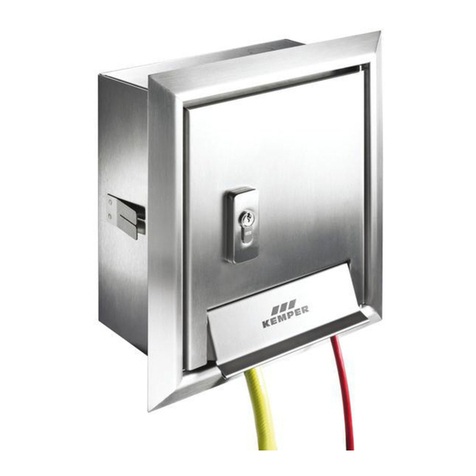
Kemper
Kemper MINI-TRESOR User manual
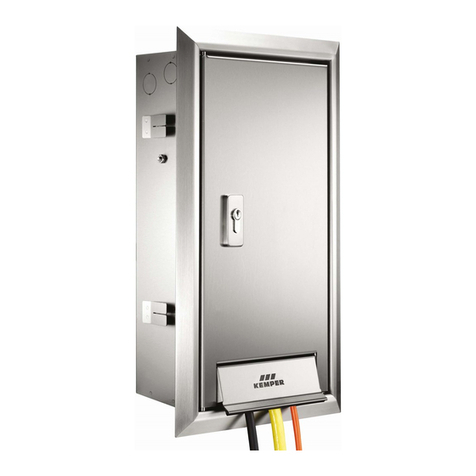
Kemper
Kemper TRESOR User manual
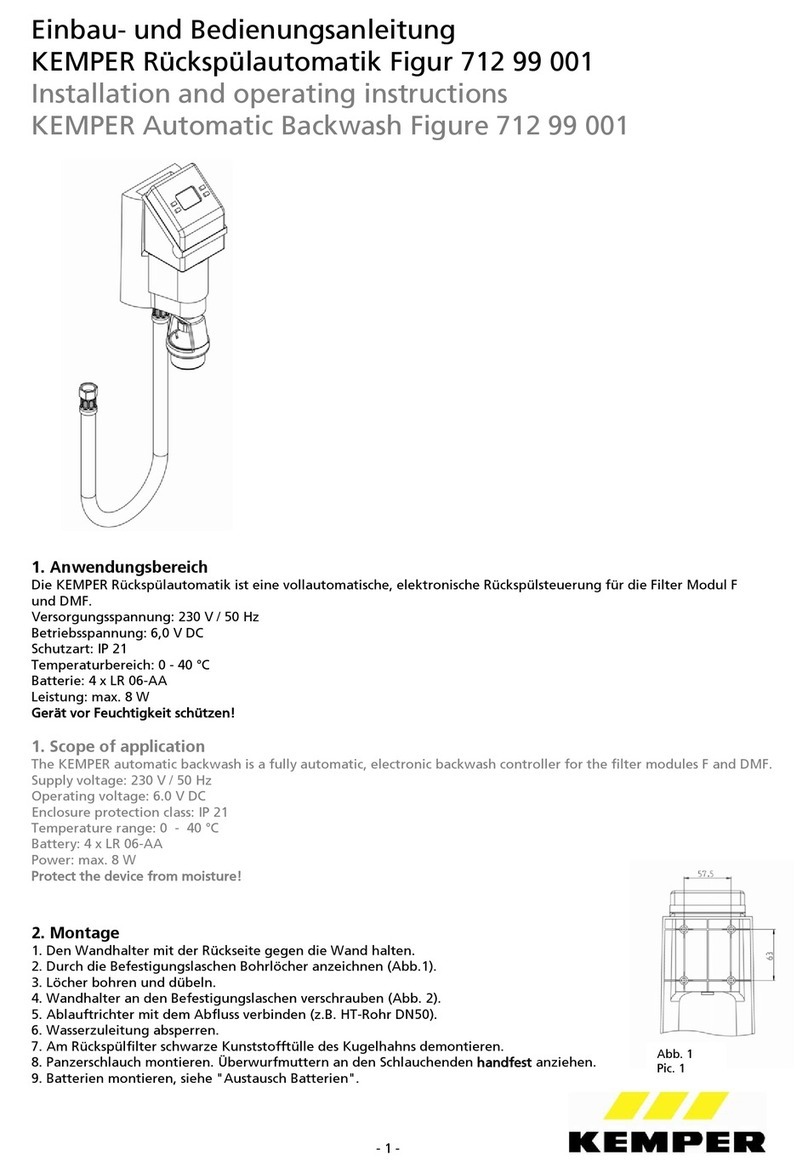
Kemper
Kemper 712 99 001 User manual

Kemper
Kemper MINI-TRESOR User manual
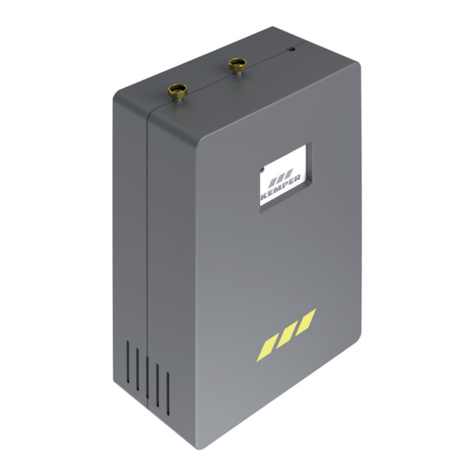
Kemper
Kemper FK-5 User manual

Kemper
Kemper FK-5 Operating and maintenance instructions
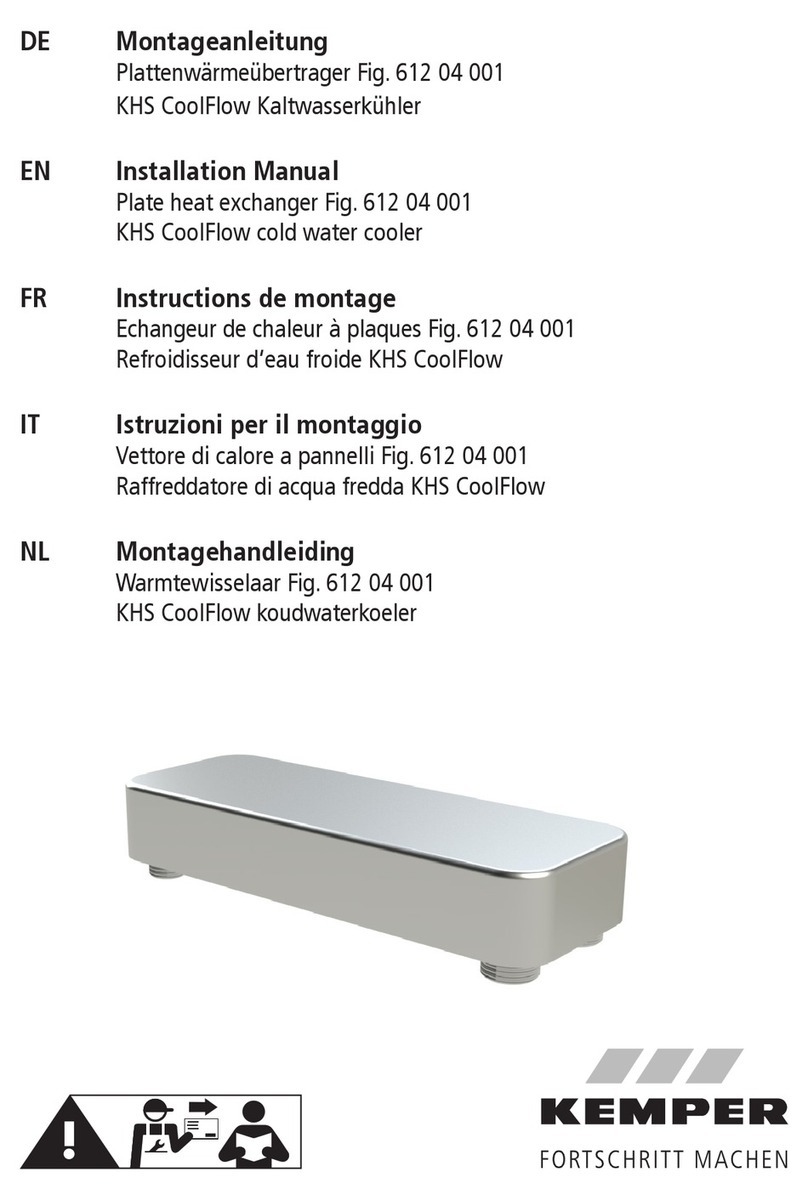
Kemper
Kemper KHS CoolFlow 612 04 001 User manual

Kemper
Kemper MINI-TRESOR User manual

